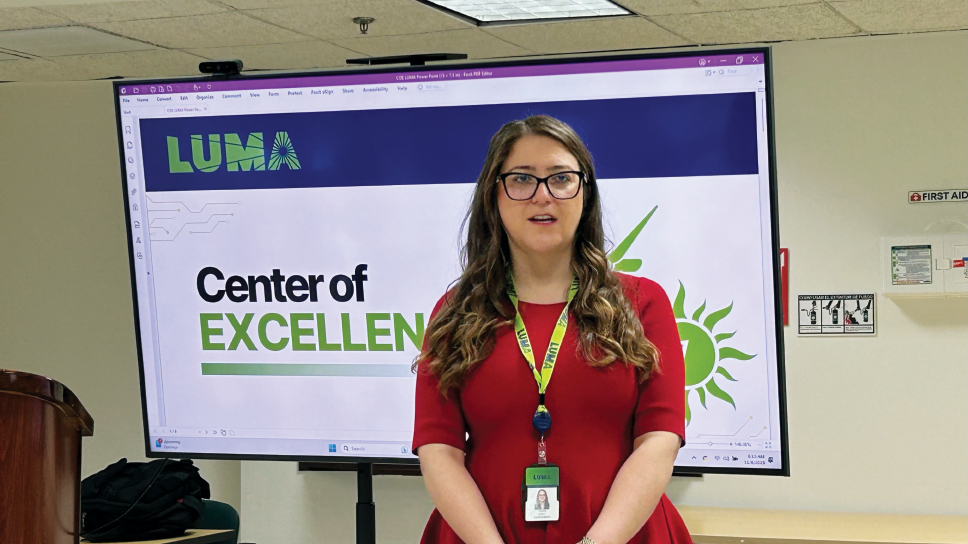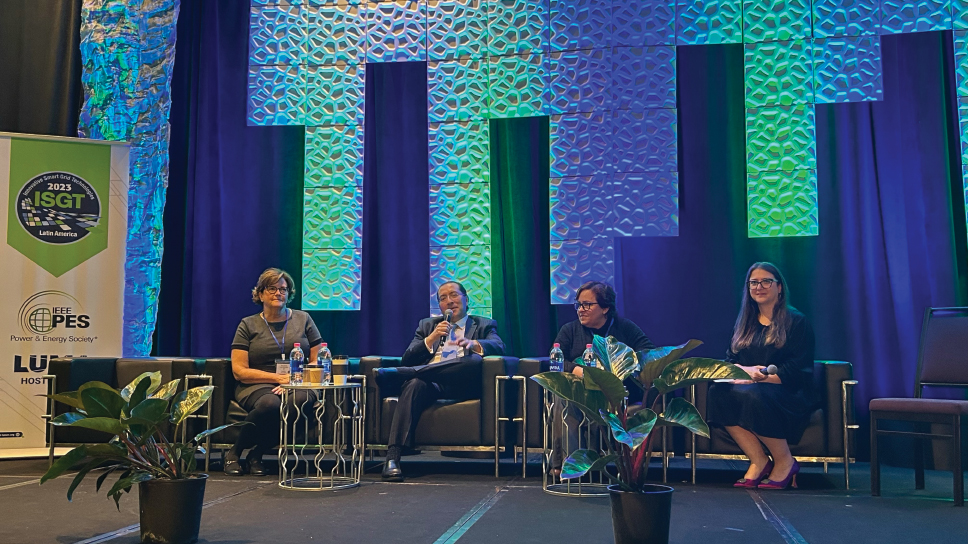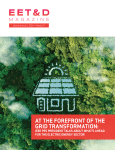In 2020, EET&D magazine wrote about Shay Bahramirad, Ph. D., who, at the time, was the vice president of new initiatives and outreach for IEEE PES. In that article, Dr. Bahramirad talked about the role IEEE PES plays in working with utilities and energy consumers. Recently, our publisher Steven Desrochers had a chance to catch up with Dr. Bahramirad, who now serves as the senior vice president of T&D strategy and sustainability for LUMA Energy in Puerto Rico. She also has just assumed the mantle of president for IEEE PES. The following is a recap of their conversation about LUMA's efforts since they assumed the role of operator for transmission and distribution in Puerto Rico, along with Bahamirad's vision for IEEE PES.
EET&D: Let me start with a LUMA-related question: What is information about the power grid in Puerto Rico that you wish people outside the island would understand?
Bahramirad: When LUMA assumed the role of grid operator for transmission and distribution in Puerto Rico in June 2021, we inherited a fragile and broken system that had not been maintained for decades, and it hadn’t been invested in for years, in addition to flaws in the system design under the prior operator, resulting in bottom of the fourth quarter reliability.
Basically, the reliability of the system was 300% worse than the worst utility in the United States. And since then, we have made tremendous progress. The largest settlement in the electric industry is the one between the Federal Government (FEMA) and Puerto Rico. There was no project under construction when we started.
As part of that transformation and reconstruction, we have initiated over 411 projects with FEMA, and 104 of them are under construction right now. As a result of that, we have improved the reliability of the system and reduced the frequency of outages by 35% in the first two years of operations. It takes time. There is a sense of urgency because of where the system is, what the software is and what the people of Puerto Rico are going through day to day, but it is also important to do this right because this investment is going to serve the next three generations of Puerto Ricans — it’s important to get it right in having this sense of urgency.

Image credit: LUMA Energy
EET&D: Thank you. How have things changed with LUMA in shoring up the power grid since you joined the organization?
Bahramirad: As I stated, we have initiated 411 FEMA projects that represent 11.7 billion dollars of investment. We are bringing the system design to industry standards such as NERC, SIP and Compliant. We have connected 102,000 solar panels to the system, which puts Puerto Rico fifth in the nation for residential solar per capita.
It’s quite impressive. The people of Puerto Rico have decided that we want 100% renewable electricity by 2050, and we are committed to that. We’ve been upgrading the system to be able to accommodate that. We have replaced over 65,000 streetlights in 78 municipalities, and we are going to replace another 200,000 in the next year and a half or so to improve public safety.
Thousands of poles have been replaced. We have installed over 2,000 automation devices to reduce the frequency of outages and reduce the duration of outages for the first time in Puerto Rico because of the optical sensors that we have implemented, we have visibility and situational awareness of the transmission system.
So, there is a lot going on. We have cleared 3,700 miles of vegetation, and we have an agreement from the federal government and with the support of Puerto Rico to do a one-time vegetation clearing for 16,000 miles of lines across Puerto Rico, which is going to improve the reliability of the system by 45% in three years.
It’s the mitigated hazard associated with [that] vegetation. It’s understated, so we are quite excited about that, and we are on target to start the work by early 2024.
These are a few highlights of what we have done so far, and the last thing I will tell you about is the people-side of this business. We have focus. It was my personal commitment to develop the next generation of local talent. We have a Memorandum of Understanding with six universities across the island. We have hired over 200 recent graduates from six universities, and we’ve led them through extensive training. The enthusiasm you see from the young talent — it’s quite impressive. We have over 70 interns from the local universities, and we have sent over a dozen engineers to extensive 61850-3 substation training in North Carolina to get award-class training by Quanta Technologies.
They are going to be the brains. They are going to operate, troubleshoot and commission complicated substation equipment and are well on their way.
EET&D: Wow. Well, I appreciate that human power in that answer you just gave me. It’s not part of the questions, but I was going to ask what’s been done because it’s a challenge. You’re on the island, and you have only so many people that you can tap into, and I know that you’ve grown the workforce by I don’t know how many over the last three years, but kudos on that.
Bahramirad: On the island, we call it brain drain. There are several very good universities, and other utilities and companies from the mainland come to hire these recent graduates. [The graduates] have a very solid and technical foundation, and we want to keep them here.
EET&D: Are you able to tap into universities outside the island?
Bahramirad: We have been working with a number of universities. We’ve just kicked off Center of Excellence, and the thought is to attract researchers and graduate students from the mainland to have a dialog with engineers from LUMA and the recent graduates that we continue to hire, and this dialogue is going to help create the foundation and benchmark for cross-country learning for our talent in Puerto Rico.
EET&D: How can LUMA be a better community partner?
Bahramirad: So, as part of our grid transformation, we have been working very closely with municipal officials to inform them that the work is coming. As part of the work to perform system upgrades, we often need to implement planned outages to ensure work can be completed safely, so we inform our customers through the municipalities and social media. They also support us during construction [because construction work] creates lots of traffic and some logistics they are part of, in addition to the permit process.
We have held several STEM events working with several community stakeholders, and the thought has been to expose the next generation of high schoolers and middle schoolers to the path of STEM. What does it look like? Fourteen female engineers from my team mentored 40 female students from across the island, partnering with community stakeholders. Together, they worked on building an electric car from scratch and raced the cars in one of our facilities.
We also had the first workshop around climate science for a number of high schools. In addition to that, we are kicking off a program to go around the island to different elementary schools and read books to the students about energy and how to save the planet.
So, that’s just the work that we are doing by our people and the team at LUMA to closer to the communities that we serve.

Image credit: LUMA Energy
EET&D: How are Luma and consumers in Puerto Rico working together more effectively?
Bahramirad: We are committed to working with customers to develop solutions for a brighter energy future in Puerto Rico. As the Puerto Rico system operator, we are responsible for implementing the public policies that the people of Puerto Rico have decided, like having 100% renewable electricity by 2050.
We’ve done several initiatives. You’ve heard about connecting over 100,000 solar panels to the system propelling Puerto Rico to rank fifth among US states and territories for residential solar per capita. We have increased the number of monthly solar connections from approximately 450 under the previous operator to approximately 4,100 interconnections per month under LUMA.
We just announced our customer battery energy sharing (CBES) initiative. It’s a future power plant if you will, and we’ve put a contract in place with a number of aggregators, and they are working very closely with customers and community leaders to get subscriptions so they can participate as part of operation during peak demand to provide that service to the grid, helping with the reliability for 1.5 million customers in Puerto Rico.
The program is going to provide participating solar customers who have battery storage the opportunity to contribute to the stability of the system during the time of lowest generation supply. Across multiple programs, we have made historic and measurable progress to strengthen the network and improve its reliability. We also have been working on providing more information to customers and doing a lot more communication through the press, social media, and other mechanisms to inform them of the work we are doing.
EET&D: Thank you. Switching to IEEE. When were you elected president of IEEE PES?
Bahramirad: Almost two years ago. But for the first two years, I was president-elect, so my role was to [work on] the long-term strategic plan, and in 2024 and 2025, I will be president to execute on those promises.
EET&D: What unique insights and experience do you bring to IEEE PES?
Bahramirad: IEEE PES is the leading provider of scientific and engineering information about electric power systems in the energy sector. I have had unique positions in the industry around the country. I have lived on three different continents, so, I am familiar with the challenges from the Middle East, to Europe, and then to the United States, and now in Region 9 of Puerto Rico, which is similar to the Caribbean. Interestingly, even though there are a lot of similarities, it gives me quite a unique view of the landscape of the energy sector. Coming from the industry at the same time, teaching for decades and working very closely with national labs, I can bring together — and I plan to bring together practitioners, as well as scientists and professors from academia, and researchers, to work together to solve a lot of problems and challenges associated with the climate crisis.
EET&D: What excites you about the role you will be playing as president of IEEE PES?
Bahramirad: It’s an exciting time to be part of this business. It’s an exciting time to be an engineer, and it’s an exciting time to be part of this energy transition, and I cannot think of a better organization than PES to create a dialogue to make proper decisions and provide unbiased facts to decision-makers globally. That excites me the most.
In addition to that, the talent that this industry needs, the younger generation, they are mission-driven, and I cannot think of a bigger humankind challenge than tackling the climate crisis that will excite the next generation. I’ve seen it in our IEEE young professionals, and I look forward to working with them over the next couple of years.
EET&D: What are some of the greatest challenges IEEE must meet over the next couple of years?
Bahramirad: We are at the forefront of the rapidly changing technological advancements that impact everyone, from grid operators to manufacturers, to communities, and the greatest challenge we face is time. Climate change is dramatically increasing the frequency and the extent of events everywhere around the world, and more resilient solutions are needed to address them. That’s why it’s important to learn from experience in places like Puerto Rico.
As experts in engineering in climate change, we are in a position at PES to discuss the latest thinking to ensure people in different parts of the world don’t have to live the same experiences. The other part that I should highlight is that gathering at conferences like the Smart Grid Conference in Puerto Rico for our global network of leading power engineers is quite important…climate change is a global phenomenon, but the impacts are seen locally, and there are a lot of parallels across the globe. IEEE is the right foundation and the right platform to bring people together and have this transparent, unbiased dialogue. It translates into the foundation of decision-making.
EET&D: I’d like to add that IEEE, like any other association… we need to go and get those students young, and we want to get them involved as early as possible, as our future generation. You said that you are part of Region 9. What do you see in the future to attract those students to embark on the IEEE association?
Bahramirad: We have a workforce development strategy that we’ve been working on for the past two years. There are elements to that from virtual job fairs for the ones that are already in college to introduce them to what IEEE PES is about and connecting the companies to students on a larger scale, where there’s no physical attendance required in one location.
We also have been looking into gaps. We have scholarship cross-programs and we’ve been looking into expanding them outside of power systems, the power sector, or electrical engineering to relevant engineering disciplines.
If you want to build a system, you are required to have civil engineers, mechanical engineers, chemical engineers and so forth, and we’ve been looking to expand that scholarship to different disciplines in engineering. In addition to that, we have STEM programs that IEEE provides and at PES we work very closely with them.
There’s Learned Engineering. It’s a program that IEEE uses, working with high school and middle school kids to expose them to all the opportunities in the world by working on a hands-on project, and during the process, they learn what opportunities are out there in the future, so there is a long spectrum of initiatives globally that is getting led by young professionals to expose the next generation and make sure that they have a proper pipeline of talent that come through IEEE and that they participate in developing standards, guidelines and the educational material that is needed to bring the talent to the next level to tackle all of the problems that we talked about.
EET&D: Is there anything you’d like to talk about that we didn’t cover?
Bahramirad: Maybe one thing I would say is that I think IEEE PES is on the right track to facilitate change globally. It’s very important to PES leadership, and to me, that we foster global connection — connecting people and experts and providing that unbiased view to decision-makers — and we are going to facilitate change. Without immediate efforts, engineers will be left with a rapidly growing crisis with no solutions.
 Shay Bahramirad, Ph. D., is globally recognized as an industry leader in defining the next horizon of the electric utility industry, Bahramirad serves as the senior vice president of engineering Asset Management and Capital Programs for LUMA Energy as well as the president-elect of IEEE PES. She is passionate about mitigating climate change and driving social equity.
Shay Bahramirad, Ph. D., is globally recognized as an industry leader in defining the next horizon of the electric utility industry, Bahramirad serves as the senior vice president of engineering Asset Management and Capital Programs for LUMA Energy as well as the president-elect of IEEE PES. She is passionate about mitigating climate change and driving social equity.
About IEEE Power & Energy Society (PES):
The IEEE Power & Energy Society (PES) is the leading provider of scientific and engineering information on electric power & energy for the betterment of society and a trusted resource dedicated to the technical, informational, networking, and professional development needs of its members. With over 40,000 members around the globe representing every facet of the electric power and energy industry, PES is at the forefront of the rapidly changing technological advancements that impact everyone’s future. Additional information on IEEE PES can be found at ieee-pes.org.








